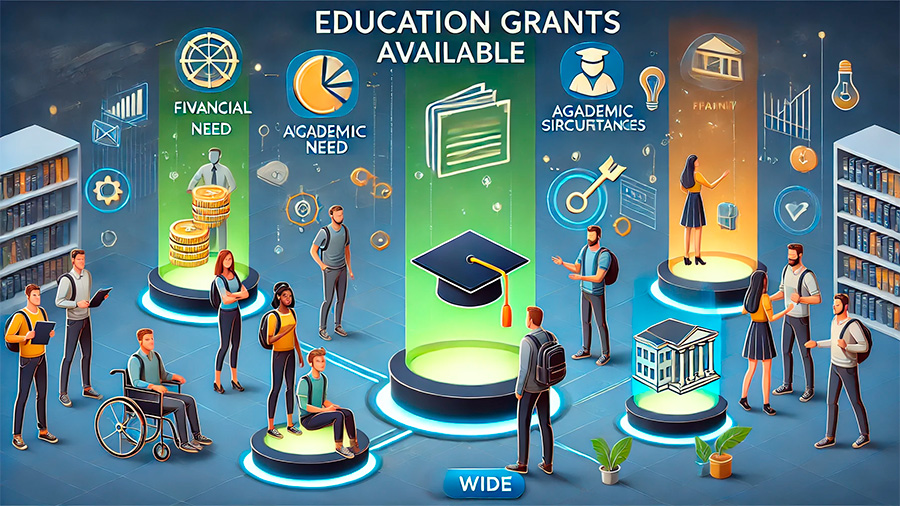Debt-Free Education: Leveraging Grants for a Brighter Future

Education is often considered the gateway to a successful career and a better quality of life. However, the rising costs of tuition and educational expenses can make higher education seem out of reach for many students. Thankfully, grants offer a solution by providing financial assistance that does not need to be repaid. Grants are an essential resource for students looking to pursue their education without the burden of long-term debt. This article explores how grants work, the types of grants available, and how you can apply for them to unlock educational opportunities.
What Are Education Grants?
Education grants are a form of financial aid provided by government agencies, universities, and private organizations to help students pay for their education. Unlike loans, grants do not require repayment, making them an attractive option for students who want to avoid accumulating debt. Grants are typically awarded based on financial need, academic performance, or specific personal circumstances, such as your field of study or background.
1. Types of Education Grants
There are several types of education grants available to students, each designed to meet different financial needs or support specific goals. Understanding the types of grants can help you identify the best options for financing your education.
Common types of education grants:
- Federal Grants: The U.S. government offers several types of federal grants, such as the Pell Grant, which is awarded to undergraduate students with financial need. Other federal grants include the Federal Supplemental Educational Opportunity Grant (FSEOG) and the Teacher Education Assistance for College and Higher Education (TEACH) Grant.
- State Grants: Many states offer grants to residents who attend in-state colleges or universities. These grants are often need-based or merit-based and are intended to reduce the cost of tuition for state residents.
- Institutional Grants: Universities and colleges often provide their own grants to students based on need or academic merit. These grants are typically awarded by the financial aid office and may be renewable each year based on continued enrollment and academic performance.
- Private Grants: Private organizations, foundations, and corporations also offer grants to students. These grants can be based on a variety of factors, including field of study, career goals, and personal background.
2. How Grants Help Students Finance Education
Grants are one of the most effective ways to reduce the financial burden of education. Because grants do not need to be repaid, they provide students with the ability to focus on their studies without the added stress of loans and debt. Grants can cover a wide range of educational expenses, including tuition, books, fees, and even living expenses in some cases.
How grants benefit students:
- No repayment: Unlike loans, grants do not need to be repaid, making them one of the most valuable forms of financial aid available to students.
- Reduce debt: By covering a portion of your tuition or related expenses, grants help you borrow less in student loans, reducing your overall debt burden after graduation.
- Pay for essential expenses: Grants can help cover not only tuition but also books, transportation, and other fees, reducing the out-of-pocket expenses you may otherwise need to pay.
- Increase educational access: Grants open doors to higher education for students from low-income backgrounds, making education more accessible to all.

Who Is Eligible for Education Grants?
Eligibility for education grants depends on several factors, including financial need, academic performance, and personal circumstances. Understanding these factors will help you determine which grants you qualify for and how to apply for them.
1. Financial Need
One of the most common eligibility requirements for grants is financial need. Government grants, such as the Pell Grant, are awarded to students who demonstrate a high level of financial need, typically based on their family’s income and the cost of their education. The FAFSA (Free Application for Federal Student Aid) is the primary tool used to assess financial need for federal grants.
How financial need is determined:
- FAFSA: The FAFSA collects financial information about the student and their family to assess the level of need. The results determine eligibility for various grants, scholarships, and other forms of financial aid.
- Family income: Lower-income families are generally eligible for more financial assistance, including grants.
- Cost of attendance: The higher the cost of the college or university, the greater the financial need may be, which could increase the likelihood of qualifying for grants.
2. Academic Merit
Many grants are awarded based on academic performance, such as high GPAs, standardized test scores, or other achievements. Merit-based grants are typically offered by universities, private organizations, and foundations, and they reward students who excel academically.
How academic merit is considered for grants:
- High school GPA: Students with strong academic records are often eligible for merit-based grants that recognize their academic achievements.
- Standardized test scores: Some grants are awarded based on high scores on exams like the SAT or ACT, making them an important consideration for students looking to maximize their financial aid.
- Field of study: Some merit-based grants are offered specifically to students pursuing certain fields of study, such as STEM or education, where there is high demand for skilled professionals.
3. Special Circumstances
In addition to financial need and academic performance, some grants are awarded based on special circumstances or personal characteristics. For example, grants may be available for students from underrepresented groups, students with disabilities, or students pursuing specific careers or fields of study.
Special circumstances that may affect eligibility:
- Disabilities: Students with disabilities may be eligible for specific grants designed to provide support for their educational needs.
- Minority status: Some grants are specifically targeted at underrepresented groups in higher education, such as students of color, women in STEM fields, or first-generation college students.
- Career goals: Grants are also available for students who want to enter fields that are experiencing a shortage of qualified professionals, such as teaching or healthcare.

How to Apply for Education Grants
The application process for grants can vary depending on the type of grant and the organization providing it. However, the general process involves completing applications, submitting required documents, and meeting deadlines. Here’s how to get started:
1. Complete the FAFSA
For federal grants, the first step in the application process is to complete the Free Application for Federal Student Aid (FAFSA). The FAFSA collects detailed financial information and helps determine your eligibility for federal financial aid, including grants.
Steps to complete the FAFSA:
- Gather financial documents: Before starting the FAFSA, gather your tax returns, W-2 forms, and other financial documents to complete the application.
- Submit the FAFSA: Complete the FAFSA online and submit it before the deadline. You can submit the FAFSA as early as October 1st for the following academic year.
- Review the Student Aid Report (SAR): After submitting the FAFSA, you’ll receive a SAR, which details your eligibility for federal grants and other forms of financial aid.
2. Apply for State and Institutional Grants
In addition to federal grants, many states and universities offer their own grants. You may need to complete separate applications for these, and each program will have its own eligibility requirements.
How to apply for state and institutional grants:
- Check with your state: Visit your state’s higher education website to find out about available state grants and the application process.
- Research university grants: Contact your university’s financial aid office to learn about institutional grants and any specific requirements for applying.
3. Apply for Private Grants
Private grants can be offered by corporations, foundations, or nonprofit organizations. These grants may be based on specific criteria, such as field of study or personal background. Research available grants, prepare your application materials, and submit them according to the instructions.
How to apply for private grants:
- Identify relevant grants: Look for private grants related to your field of study, career goals, or personal background.
- Prepare your application: Gather required materials, such as essays, letters of recommendation, and transcripts, to submit with your application.
- Meet deadlines: Make sure to submit applications by the deadline and follow up to confirm that your application has been received.
Conclusion
Education grants are an invaluable resource for students seeking to finance their education without the burden of repayment. Whether offered by the federal government, state agencies, universities, or private organizations, grants provide financial assistance based on need, merit, or special circumstances. By understanding the types of grants available, the eligibility criteria, and the application process, students can unlock opportunities for higher education and reduce the need to take on excessive student debt. With the right grants, education can become more accessible, affordable, and attainable for all students.
